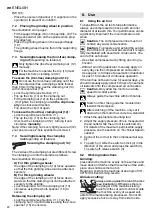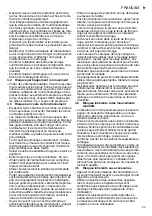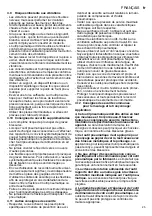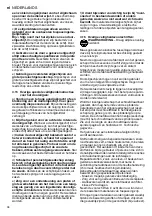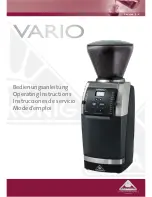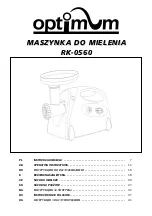
ENGLISH
en
21
.
Danger!
Disconnect the compressed air con-
nection before carrying out any work.
Danger!
Repair and maintenance work other
than described in this section should only be
carried out by
qualified specialists
.
- Carry out regular maintenance to ensure the
safety of the air tool.
- Check that all screw fittings are seated securely,
and tighten if necessary.
- Clean the filter in the compressed air connection
at least once a week.
- It is recommended that you install a pressure
reducer with an air-water separator and lubricator
upstream of the air tool.
- If a large amount of air or oil is escaping, check the
air tool and have it maintained if necessary. (see
Section 11.)
- Check the rotational speed regularly and after
every use. Also carry out a simple check on vibra-
tion emission.
- Regularly check the spindle, thread and clamping
devices for wear and tolerance for accommo-
dating mounted tools.
- Avoid contact with dangerous substances that
have collected on the tool. Wear suitable personal
protective equipment and take appropriate meas-
ures to remove any dangerous substances before
maintenance.
f
Use only genuine Metabo accessories.
Only use accessories that are designed for this air
tool and that fulfil the requirements and the specifi-
cations listed in these operating instructions.
For a complete range of accessories, see
www.metabo.com or the catalogue.
Danger!
Repairs to air tools must only be
carried out by qualified specialists, using orig-
inal Metabo spare parts!
If you have Metabo air tools that require repairs,
please contact your Metabo service centre. For
addresses see www.metabo.com.
You can download spare parts lists from
www.metabo.com.
The sanding dust generated may contain
hazardous materials: do not dispose of this dust
with household waste, but at a special collection
point for hazardous waste.
Observe national regulations on environmentally
compatible disposal and on the recycling of disused
air tools, packaging and accessories. You must not
cause risks to people or the environment.
Explanatory notes on the specifications on page 3.
Subject to change in line with technological
advances.
V
1
= Air requirement
p
max.
= Maximum permissible supply pressure
D
max
= Max. diameter of mounted tool
t
max,1
= Max. permitted thickness of clamping
shank on mounted tool when using
clamping nut (14)
t
max,2
= Max. permitted thickness of shank on
mounted tool when using
"Quick"clamping nut (12)
t
max,3
= Roughing wheel/cut-off wheel:
max. permissible thickness of the
mounted tool
M
= Spindle thread
l
= Length of the grinding spindle
n
= No-load speed (maximum speed)
d
i
= Hose diameter (inner)
C
= Connecting thread
A
= Dimensions:
Length x Width x Height
m
= Weight
The technical specifications quoted are subject to
tolerances (in compliance with the relevant valid
standards).
Emission values
Using these values, you can estimate the
emissions from this tool and compare these with the
values emitted by other tools. The actual values
may be higher or lower, depending on the particular
application and the condition of the tool or mounted
tools. In estimating the values, you should also
include work breaks and periods of low use. Based
on the estimated emission values, specify protec-
tive measures for the user - for example, any organ-
isational steps that must be put in place.
Vibration (acceleration value, frequency-weighted
according to EN 28927):
a
h
=Vibration emission level
K
h
=Measurement uncertainty (vibration)
Sound level (EN ISO 15744):
L
pA
=Sound pressure level
L
WA
=Acoustic power level
K
pA
, K
WA
= Measurement uncertainty
Wear ear protectors!
9. Care and Maintenance
10. Accessories
11. Repairs
12. Environmental Protection
13. Technical specifications














